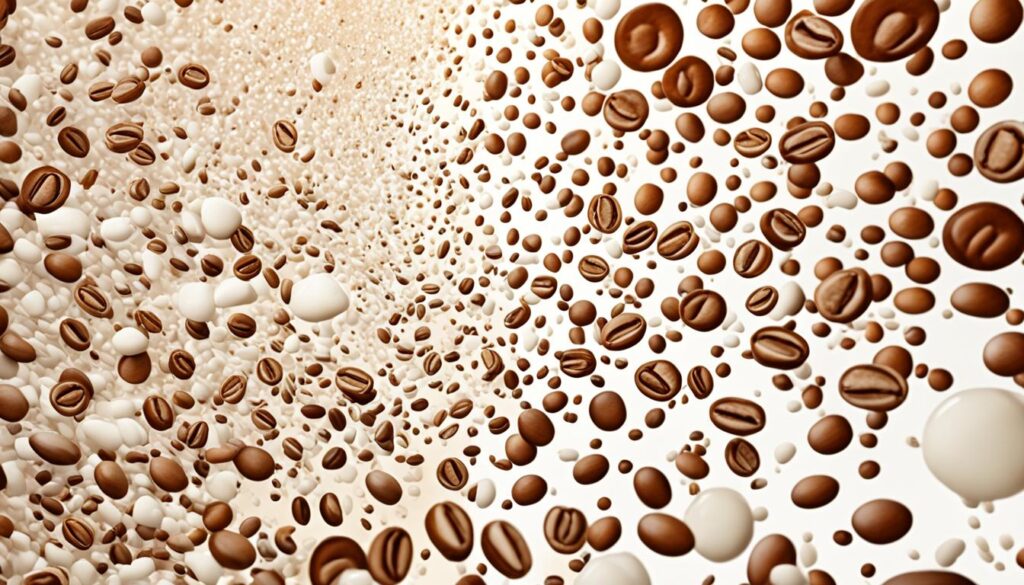Milk in coffee is more than just a morning routine. It is a fascinating blend of science and art that involves a complex process known as turbulent mixing. This process not only affects the taste and texture of your morning cup, but it also has real-world implications in various industries.
The Whiting School of Engineering has conducted groundbreaking research on the science behind milk in coffee. Their findings reveal that stirring milk into coffee induces turbulent flow, resulting in a well-mixed cup of coffee. This understanding of fluid dynamics has far-reaching implications, from enhancing chemical reactors to improving water treatment processes.
Delving into the science of milk in coffee allows us to gain insights into the secrets of turbulence and other scientific challenges. By understanding the interplay between milk and coffee, we can uncover the fascinating world of milk coffee science and milk foam chemistry.
Key Takeaways:
- The process of stirring milk into coffee induces turbulent flow, resulting in a well-mixed cup of coffee.
- The science behind milk in coffee has implications for industries such as chemical reactors and water treatment.
- Understanding the interplay between milk and coffee can enhance our knowledge of turbulence and other scientific challenges.
- Exploring the secrets of milk coffee science and milk foam chemistry adds depth to our coffee experience.
- Unveiling the science behind milk in coffee enhances our appreciation for this fascinating blend of art and science.
The Impact of Bean Selection on Espresso Flavor
When it comes to brewing the perfect espresso, the importance of bean selection cannot be overstated. The flavor of your espresso is deeply influenced by the beans you choose. Each coffee-growing region produces beans with unique flavor profiles, making the origin a crucial factor to consider.
Understanding the characteristics of different coffee-growing regions allows us to explore a world of flavors. For example, beans from Ethiopia often exhibit fruity and floral notes, while those from Colombia may have a milder acidity with nutty undertones. By selecting beans that align with our taste preferences, we can craft espressos that truly satisfy.
The roast level is another critical element that impacts the flavor of your espresso. Lighter roasts tend to be more acidic and showcase delicate floral and citrus notes. On the other hand, darker roasts offer a bolder flavor with hints of chocolate and caramel. The choice between a light or dark roast depends on personal preference and the desired flavor experience.
One of the key factors that contribute to the quality of the coffee is freshness. Freshly roasted beans retain more flavor and aromatic compounds, resulting in a superior cup of espresso. To ensure the utmost freshness, it is advisable to avoid pre-ground coffee. Instead, opt for whole beans that can be ground just before brewing, releasing the full potential of their flavors.
“The journey to the perfect espresso starts with the selection of high-quality coffee beans.”
By prioritizing the importance of bean selection, considering the coffee-growing regions, roast level, and freshness, we can elevate our espresso experience. It’s a journey of exploration and discovery, uncovering the diverse flavors and nuances that coffee has to offer.
Experience the aromatic symphony of carefully selected beans, roast to perfection, and brewed with passion. Let each sip transport you to the lush coffee plantations of distant lands.
The Key Factors in Brewing the Perfect Espresso
Achieving the perfect espresso requires attention to detail. To ensure a flavorful and well-extracted cup of coffee, several key factors come into play – from the art of grinding to mastering the espresso machine.
The Art of Grinding
The coarseness or fineness of the coffee grounds significantly affects the extraction process and overall flavor. Investing in a burr grinder is highly recommended as it allows for consistent grind size and ensures even extraction.
Mastering the Espresso Machine
The espresso machine’s temperature and pressure play crucial roles in achieving a balanced extraction. Optimal water temperature and consistent pressure throughout the brewing process bring out the best flavors in the coffee. It’s important to invest in a quality espresso machine that provides stability and precision.
The Perfect Extraction
In addition to the grind and machine, the ideal brew time and shot volume contribute to a well-extracted espresso. Understanding the desired flavors and finding the right balance between strength and extraction time is essential for brewing the perfect cup.
By paying attention to these key factors – the art of grinding, mastering the espresso machine, and achieving the perfect extraction – we can elevate our coffee brewing skills and enjoy a truly exceptional cup of espresso.

| Key Factors | Impact on Espresso Quality |
|---|---|
| The Art of Grinding | Consistent grind size for even extraction |
| Mastering the Espresso Machine | Stable water temperature and consistent pressure lead to balanced extraction |
| The Perfect Extraction | Optimal brew time and shot volume for well-extracted flavors |
The Science Behind Milk Steaming and Latte Art
For milk-based espresso beverages like lattes and cappuccinos, understanding the science behind milk steaming is essential. It not only affects the taste and texture of the final product but also plays a crucial role in the art of latte making.
When steaming milk, choosing the right temperature is key. Heating the milk too much can lead to scalding, while overheating can diminish the natural sweetness and alter the texture. The ideal temperature for milk steaming is around 150°F (66°C). This preserves the milk’s natural flavors and ensures a velvety texture for the final drink.
But what exactly happens when we steam milk? It’s all about the movement of milk proteins. When milk is steamed, the high temperature causes the proteins, primarily casein and whey, to denature and unfold. This unfolding creates a network of proteins that traps air bubbles, resulting in a silky microfoam.
Steaming Techniques for the Perfect Milk Texture
Steaming milk to achieve the desired texture requires both introducing air and proper technique. Here are some milk steaming techniques to master:
- Stretching: This technique involves positioning the steam wand close to the milk’s surface to create a frothy layer by quickly injecting air. It’s essential to start with cold milk and submerge the steam wand slightly below the surface to prevent large bubbles.
- Texturing: Once the desired volume is reached, the steam wand is lowered deeper into the milk to distribute and texture the foam. The angle of the pitcher and the position of the steam wand can influence the outcome. Texturing creates a smooth and glossy texture in the milk.
Mastering these techniques takes practice, but with time, you’ll be able to create perfect microfoam consistently.
Latte Art: Adding Visual Appeal to Your Coffee
Once you’ve steamed the perfect milk with velvety microfoam, the next step is to create beautiful latte art. It’s an artistic expression that adds visual appeal and finishing touch to your coffee creations.
Latte art involves pouring the steamed milk carefully into the espresso shot, manipulating the flow and position to create patterns or designs. Common latte art designs include hearts, rosettas, and tulips. Mastering the technique requires precision and a steady hand.
Remember, the combination of milk steaming and latte art is a blend of both science and art. By understanding the science behind milk proteins, the right temperature for steaming, and mastering proper techniques, you can create not only a delicious cup of coffee but also a visually stunning work of art.
The Promising Potential of Polyphenols in Combating Inflammation
When it comes to maintaining a healthy body, inflammation is a key factor to consider. Chronic inflammation has been associated with various health conditions such as heart disease, diabetes, and even certain types of cancer. Fortunately, nature has provided us with a powerful ally in the fight against inflammation – polyphenols.
Polyphenols are a diverse group of antioxidants found in abundance in humans, plants, fruits, and vegetables. These compounds have been extensively studied for their potential health benefits. One area of research that has garnered significant attention is the anti-inflammatory effect of polyphenols.
Studies have shown that polyphenols can help reduce oxidative stress and inflammation in the body. Oxidative stress occurs when there is an imbalance between free radicals and antioxidants, leading to damage at the cellular level. By neutralizing free radicals, polyphenols can help reduce oxidative stress and its associated inflammatory response.
But what makes polyphenols even more intriguing is their interaction with proteins. Researchers have observed that when polyphenols are combined with amino acids, their inhibitory effect on inflammation in immune cells is enhanced. This protein reaction highlights the potential synergistic relationship between polyphenols and proteins in combating inflammation.
So, how can we incorporate polyphenols into our diet to reap their anti-inflammatory benefits? One delicious option is by enjoying coffee with milk. Coffee is a rich source of polyphenols, and when combined with protein-rich milk, it may have even more significant effects on inflammation. The combination of polyphenols and proteins creates a powerful anti-inflammatory duo, potentially offering added protection against chronic inflammation.
However, it’s important to note that further research is needed to fully understand the mechanisms of action and optimal dosage for polyphenols’ anti-inflammatory effect. Nonetheless, incorporating polyphenol-rich foods, such as coffee with milk, into a well-balanced diet may have positive implications for our overall health and well-being.
To summarize, polyphenols show promising potential in combating inflammation by reducing oxidative stress and interacting with proteins. Coffee with milk, as a source of both polyphenols and proteins, may offer additional anti-inflammatory benefits. While more research is needed, incorporating polyphenol-rich foods into our diet can contribute to a healthier lifestyle.

| Polyphenols | Inflammation | Anti-inflammatory Effect | Protein Reaction | Coffee with Milk | Powerful antioxidants found in humans, plants, fruits, and vegetables | An immune response that can become chronic and lead to various health conditions | Reduces oxidative stress and inflammation in the body | Enhances inhibitory effect on inflammation when combined with amino acids | A delicious way to consume polyphenols and proteins together |
|---|
Conclusion
Brewing the perfect espresso is a harmonious blend of art and science. Each step of the process, from carefully selecting the coffee beans to achieving the ideal extraction, requires meticulous attention to detail. By understanding the science behind milk steaming and appreciating the potential health benefits of polyphenols in combating inflammation, we can elevate our coffee experience to new heights.
As we delve into the world of coffee, we discover that the quality of the beans greatly impacts the flavor of our espresso. The origin of the beans, the roast level, and the freshness all contribute to a unique and enjoyable outcome. By being mindful of these factors, we can savor the distinct nuances of coffee from different regions and maximize the flavors we derive.
Mastering the espresso machine is also essential in brewing the perfect cup. From the coarseness of the grind to the stable water temperature and consistent pressure, every element contributes to achieving a well-balanced extraction. Our commitment to understanding the intricacies of the process leads us to explore various brewing techniques and refine our skills.
Lastly, we embrace the artistry of milk steaming and latte art to create visually stunning espresso beverages. By choosing high-quality milk, steaming it to the ideal temperature, and mastering the texture, we enhance the entire coffee drinking experience. The marriage of science and art in the form of latte art elevates our enjoyment and allows us to express our creativity.
Through continuous exploration and refinement of these factors, we can unlock the secrets to a truly exceptional cup of coffee. So grab your favorite brewing equipment, embark on this exciting journey, and elevate your coffee experience, one perfect cup at a time.
FAQ
How does stirring milk into coffee create turbulent flow?
When milk is stirred into coffee, it induces turbulent flow, which leads to a well-mixed coffee. This is due to the fluid dynamics involved in the mixing process.
Why is bean selection important for espresso flavor?
Bean selection plays a significant role in espresso flavor. Different coffee-growing regions produce beans with unique flavor profiles, while the roast level determines the acidity and flavor intensity. Freshness is also crucial for retaining flavor.
What factors contribute to brewing the perfect espresso?
Several factors contribute to brewing the perfect espresso, including the coarseness or fineness of the coffee grounds, the temperature and pressure of the espresso machine, the brew time, and shot volume. Paying attention to these factors ensures a well-extracted espresso.
What is the science behind milk steaming and latte art?
Steaming milk involves achieving the right temperature and texture by introducing air. Understanding milk proteins and steaming techniques is essential. Additionally, once the perfect milk texture is achieved, latte art techniques can be applied to enhance the visual appeal of espresso creations.
What are the potential health benefits of polyphenols in coffee with milk?
Polyphenols, combined with amino acids found in milk, have shown promise in reducing inflammation in immune cells. The consumption of coffee with milk, rich in polyphenols and proteins, may have potential anti-inflammatory effects. However, further research is needed to understand these health benefits more fully.




